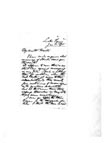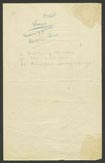John Bulmer was manager of Lake Tyers Mission from its inception in 1861 until being ‘relieved’ of his role in 1908. He first came to Victoria in 1852, apprenticed to a carpenter. Bulmer noted he first met Aboriginal people on the goldfields and became concerned about what he observed of their state and their treatment by the colonists. This led to Bulmer stopping his carpentry apprenticeship and becoming a missionary. As a missionary, Bulmer and fellow missionary Thomas Goodwin, worked at the Yelta mission, at the junction of the Murray and Darling Rivers, from the mid-1850s onwards.
Bulmer was an evangelical Anglican, so his approach towards the Aboriginal people he met at Yelta and at Lake Tyers, was to work to remind them of their faith in God and his word – that is to ‘save’ them. Such evangelical beliefs of a common origin of humankind were being challenged in the nineteenth century in anthropological society meeting rooms and journals, where debates about physical characteristics of race, separate origins of different human races and social evolution held sway. Such ideas positioned characteristics of race as fixed and physical and Aboriginal people as evidence of earlier reiterations of man. Much of these debates served to reinforce the superiority of people such as the British and justify colonisation, but this did not mean that Bulmer’s approach was removed from notions of ‘otherness’. His evangelical faith was tied up in ideas of Aboriginal people having forgotten God, becoming ‘degenerated’. His ‘hope’ in ‘saving’ them was through a return to God and Christianity. This did mean that Bulmer did try and learn local Aboriginal languages. As historian Helen Gardner noted, evangelicals believed God revealed his word to each person in language and so through learning language missionaries could help Aboriginal people return to God. This has resulted in challenges as archives, such as those in this project, contain information about Aboriginal language, knowledge and practices collected by people who were also actively trying to stop these languages, knowledge and practices being continued. Bulmer complained of difficulty translating gospel into language at Yelta, although he was observed by Reverend Septimus Chase preaching in language there in 1861.
Bulmer left Yelta due to his wife being ill. She died shortly after their return to Melbourne. Bulmer remarried in 1862, his wife Caroline joining him at Lake Tyers. William Thomas, in his role as Guardian of the Aborigines, had proposed a site near Buchan as a potential reserve for Aboriginal people. Bulmer headed to that area, but whilst there was encouraged by some of the Gunaikurnai men and women to travel with them down to Bung Yarnda. It was this site Bulmer was encouraged to settle in the mission that became known as Lake Tyers. From the start of Bulmer’s settling in the area, a number of Gunaikurnai families lived close by. Bulmer was concerned that for many years some residents eschewed newly constructed huts to remain in camps close by. Bulmer recorded what he described as fighting amongst the families in these early years, believing it to be often related to matrimonial practices. Bulmer showed little understanding for practices such as regulation of campsites, determining who slept where, nor for marital practices that ensured the continuation of complex kinship relations.
The families who stayed at Lake Tyers or nearby resisted his attempts to get them to work for rations – and this became an ongoing tension, as Bulmer wrote in 1898 ‘I think it rather absurd that the blacks should require payment for work done in the garden, as they eat the vegetable grown.’ Residents departed Lake Tyers regularly across the decades, to work as shearers or in hop picking, earning more money than they could working the farm at Lake Tyers. It also showed that despite Government legislation over the decades and the intention of Bulmer to provide Lake Tyers as the home for Gunaikurnai people and others, the residents continued to move on and off the mission. indicated they desired payment for services rendered and agency over their lives beyond the routines and requirements of the mission.
Whilst the agency of some residents may have caused Bulmer some consternation, he was also an advocate for them. Before appearing at the 1877 Royal Commission on the Aborigines Bulmer asked the residents for their answers to the questions he had be sent, to ensure their views on payment for work, boarding out orphaned children and having a store at Lake Tyers were heard before the Commissioners. And despite his complaints about residents being paid, he did ensure they were paid for work, despite resistance from the Board for Protection of the Aborigines. Over many years Bulmer paid the residents out of his own pocket and from the sale of arrowroot grown at Lake Tyers. He continued to allow hunting, fishing and spear making, albeit regulated to fit in with mission life, and included Aboriginal people in conciliation measures in a manner only matched by John Green at Coranderrk.
Later in his life, as he wrote memoirs that are now in the Museums Victoria archives, Bulmer wrote nostalgically about Aboriginal people, questioning the ‘civilising’ process he had been a part of. He noted the violent aggression of colonists, stating that when ‘a white man had been killed it was mostly their own fault. Sometimes a hutkeeper would be killed but on enquiry it was found the white man was the aggressor.’ Bulmer’s life at Lake Tyers and amongst the Gunaikurnai and others reveals the complications of these relationships. Whilst part of the colonising process, Bulmer also advocated on behalf of the Gunaikurnai and other Aboriginal people. Whilst removing weapons from them, he did not step in to prevent marriages that continued complex kinship practices, in comparison to Rev. Hagenauer at Ramahyuck. His letters and reports reveal both frustrations at Aboriginal people not acting as he wished whilst relying on them at times for information and support.
Bulmer died in 1913 and within five days the residents of Lake Tyers had sent a petition requesting that Bulmer’s wife Caroline and daughter Ethel could continue to live there. In a second petition residents noted that they had ‘been brought up with the Bulmer Family and it will be very hard for them to part from us.’ This reinforces there was some affection between the Bulmers and the Lake Tyers’ residents. Caroline was seen as a challenge to the authority of the manager, taking the side of the residents instead and so she and Ethel were asked by the Board to leave the reserve.
Bulmer was also a friend of Howitt’s and one that caused Howitt concern. Howitt would visit Lake Tyers around Christmas, as he and his family holidayed nearby, and the two men had a correspondence that lasted a number of years. Bulmer provided Howitt with information and contacts with Gunaikurnai and other Aboriginal people, as well as overseeing arrangements for meeting with informants, that helped Howitt in his work. However, Howitt confided to Fison that he believed Bulmer was a ‘goodfellow in spite of his being a missionary’ and as being ‘very obliging, but he does not know how to enquire and is not able to learn apparently’. Howitt despaired to Fison that Bulmer had ‘no method and…no scientific bent of mind.’ From his end, Bulmer was supportive of Howitt’s work, being ‘enthusiastic’ about Kamilaroi and Kurnai and not finding ‘anything to criticise except some few points in the spelling of Kurnai words’. Despite Howitt’s complaints he lists Bulmer in the introduction to his book, The Native Tribes of South-East Australia, as one of the ‘gentlemen to whom I am especially indebted for most important contributions’. Their correspondence in these archives contains important kinship and cultural information.
References:
Central Board Appointed to Watch Over the Interests of the Aborigines, First Report of the Central Board Appointed to Watch Over the Interests of the Aborigines in the Colony of Victoria, John Ferres, Government Printer, Melbourne, 1861
Central Board Appointed to Watch Over the Interests of the Aborigines, Fifth Report, John Ferres, Government Printer, Melbourne, 1866.
Board for the Protection of the Aborigines, Seventh Report, John Ferres, Government Printer, Melbourne, 1871
Board for the Protection of the Aborigines, Thirteenth Report, John Ferres, Government Printer, Melbourne, 1877
Board for the Protection of the Aborigines, Forty-fourth Report, J. Kemp, Government Printer, Melbourne, 1909.
Fourth Annual Report of the Melbourne Church of England Mission to the Aborigines of Victoria, Mason and Firth, Melbourne, 1858
Seventh Annual Report of the Melbourne Church of England Mission to the Aborigines of Victoria, Mason and Firth, Melbourne, 1861
Forty-third Annual Report of the Church of England Mission of the Diocese of Melbourne to the Aborigines, Crawford & Bon, Melbourne, 1898
Royal Commission on the Aborigines, John Ferres, Government Printer, Melbourne, 1877.
Petition to Board for the Protection of the Aborigines, PROV, VPRS 1694/P0, Unit 6, Bundle 2, undated but received 18 August 1913
Petition to Governor of Victoria, PROV, VPRS 1694/P0, Unit 12, Bundle 4, 9th September 1913.
Bulmer papers, Museums Victoria.
A W Howitt, The Native Tribes of South East Asia, MacMillan and Co, London, 1904.
Peter Carolane, Instinct for Mission: John Bulmer, Missionary to the Aborigines of Victoria, 1855-1913, unpublished PhD thesis, University of Melbourne, 2009
Helen Gardner, ‘The ‘Faculty of Faith’: Evangelical Missionaries, Social Anthropologists and the claim for Human Unity in the 19th Century’, in Bronwen Douglas & Chris Ballard (eds.), Foreign Bodies: Oceania and the Science of Race, ANU E Press, Canberra, 2008, pp. 259-282
Victoria Haskins, ‘Give To Us The People We Would Love To Be Amongst Us’, Provenance: The Journal of Public Record Office Victoria, no. 7, 2008, pp. 1-11
John Bulmer
Found in Transcriptions
-
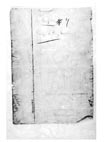 Chapter 7 Songs and SongmakersPages 6Registration Number XM461Author Howitt, Mr Alfred WilliamPhysical Description Draft notes, typed and handwritten, undated. Twelve sheets, thirteen pages. Cover sheet. Annotations throughout. Condition: tattered edges; foxing.
Chapter 7 Songs and SongmakersPages 6Registration Number XM461Author Howitt, Mr Alfred WilliamPhysical Description Draft notes, typed and handwritten, undated. Twelve sheets, thirteen pages. Cover sheet. Annotations throughout. Condition: tattered edges; foxing. -
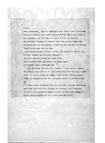 Typed and handwritten notes about the KurnaiRegistration Number XM524Author Howitt, Alfred WilliamPhysical Description Notes, typed and handwritten, undated. Handwritten sections include annotations and corrections throughout. Number 2 typed, top right of first page. No other page numbers marked. Five sheets, six pages. Condition: paper loss from bottom corner of one sheet; foxing.
Typed and handwritten notes about the KurnaiRegistration Number XM524Author Howitt, Alfred WilliamPhysical Description Notes, typed and handwritten, undated. Handwritten sections include annotations and corrections throughout. Number 2 typed, top right of first page. No other page numbers marked. Five sheets, six pages. Condition: paper loss from bottom corner of one sheet; foxing. -
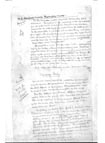 Notes about Camping and Food DivisionPages 18Registration Number XM702Author Howitt, Mr Alfred WilliamPhysical Description Draft notes, handwritten in ink, undated. Annotations and subheadings, throughout. Vertical line through almost all the pages. 13 sheets, 14 pages. Condition: foxing; some pages with tattered edges.
Notes about Camping and Food DivisionPages 18Registration Number XM702Author Howitt, Mr Alfred WilliamPhysical Description Draft notes, handwritten in ink, undated. Annotations and subheadings, throughout. Vertical line through almost all the pages. 13 sheets, 14 pages. Condition: foxing; some pages with tattered edges. -
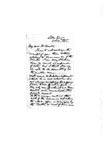 Letter from John Bulmer 10 October 1878Pages 6Registration Number XM78Author —Physical Description Letter, handwritten, ink. Two sheets, eight pages. Condition: Fair; slight tear on main fold at bottom; centre crease fragile.
Letter from John Bulmer 10 October 1878Pages 6Registration Number XM78Author —Physical Description Letter, handwritten, ink. Two sheets, eight pages. Condition: Fair; slight tear on main fold at bottom; centre crease fragile. -
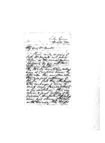 Letter from Bulmer 20 April 1880Pages 8Registration Number XM82Author —Physical Description Letter, handwritten in ink. Signed and dated. Three folded sheets, eleven pages. Vertical, red-pencil line through text on three pages. Condition: fair; small tears along central folds; slightly tattered upper edges.
Letter from Bulmer 20 April 1880Pages 8Registration Number XM82Author —Physical Description Letter, handwritten in ink. Signed and dated. Three folded sheets, eleven pages. Vertical, red-pencil line through text on three pages. Condition: fair; small tears along central folds; slightly tattered upper edges. -
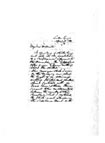 Letter from John Bulmer 28 April 1881Pages 2Registration Number XM85Author —Physical Description Letter, handwritten, ink. Signed and dated. Single folded sheet, three pages. Condition: good.
Letter from John Bulmer 28 April 1881Pages 2Registration Number XM85Author —Physical Description Letter, handwritten, ink. Signed and dated. Single folded sheet, three pages. Condition: good. -
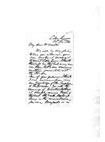 Letter from John Bulmer 26 October 1881Pages 2Registration Number XM88Author —Physical Description Letter, handwritten in ink. Single folded sheet; three pages. Signed and dated. Condition: good.
Letter from John Bulmer 26 October 1881Pages 2Registration Number XM88Author —Physical Description Letter, handwritten in ink. Single folded sheet; three pages. Signed and dated. Condition: good. -
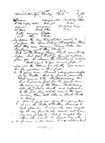 Information from John Bulmer, n.d.Pages 2Registration Number XM98Author Bulmer, Reverend JohnPhysical Description Notes and a table, handwritten, undated. One large sheet folded in half with an additional smaller sheet, six pages. Notes are possibly a letter. Fragile condition, insect damage upper edging.
Information from John Bulmer, n.d.Pages 2Registration Number XM98Author Bulmer, Reverend JohnPhysical Description Notes and a table, handwritten, undated. One large sheet folded in half with an additional smaller sheet, six pages. Notes are possibly a letter. Fragile condition, insect damage upper edging. -
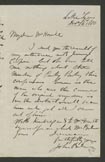 Bulmer to Howitt 4/12/1880Pages 1Registration Number hw0395Author —Physical Description Covering letter signed and dated with six additional pages referred to a as report of an interview by Rev Bulmer.
Bulmer to Howitt 4/12/1880Pages 1Registration Number hw0395Author —Physical Description Covering letter signed and dated with six additional pages referred to a as report of an interview by Rev Bulmer. -
 Howitt to Bulmer 18/April/1899Pages 1Registration Number hw0401Author —Physical Description Draft letter handwritten in black ink with pencil annotations.
Howitt to Bulmer 18/April/1899Pages 1Registration Number hw0401Author —Physical Description Draft letter handwritten in black ink with pencil annotations. -
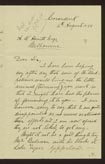 Shaw to Howitt 4 August 1898Pages 1Registration Number hw0425Author —Physical Description Handwritten in ink. Signed and dated. Annotation top left of first page.
Shaw to Howitt 4 August 1898Pages 1Registration Number hw0425Author —Physical Description Handwritten in ink. Signed and dated. Annotation top left of first page. -
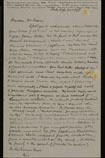 Howitt to Fison 20/9/1878Pages 7Registration Number tip70-10-33-18Author —Physical Description Handwritten in ink, signed and dated.
Howitt to Fison 20/9/1878Pages 7Registration Number tip70-10-33-18Author —Physical Description Handwritten in ink, signed and dated. -
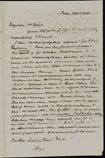 Howitt to Fison 5 November 1880Pages 3Registration Number tip70-10-34-20Author —Physical Description Handwritten in ink, signed and dated.
Howitt to Fison 5 November 1880Pages 3Registration Number tip70-10-34-20Author —Physical Description Handwritten in ink, signed and dated.
Also found in
-
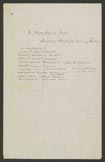 Notes on WembaioRegistration Number hw0177Author —Physical Description —
Notes on WembaioRegistration Number hw0177Author —Physical Description — -
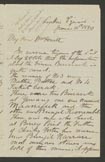 Bulmer to Howitt 10/June/1880Registration Number hw0392Author —Physical Description —
Bulmer to Howitt 10/June/1880Registration Number hw0392Author —Physical Description — -
 Bulmer to Howitt 22/October/1880Registration Number hw0393Author —Physical Description —
Bulmer to Howitt 22/October/1880Registration Number hw0393Author —Physical Description — -
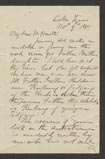 Bulmer to Howitt 9/Nov/1880Registration Number hw0394Author —Physical Description —
Bulmer to Howitt 9/Nov/1880Registration Number hw0394Author —Physical Description — -
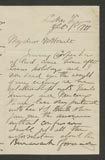 Bulmer to Howitt 1/July/1881Registration Number hw0396Author —Physical Description —
Bulmer to Howitt 1/July/1881Registration Number hw0396Author —Physical Description — -
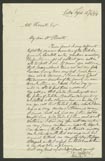 Bulmer to Howitt 12/April/1899Registration Number hw0397Author —Physical Description —
Bulmer to Howitt 12/April/1899Registration Number hw0397Author —Physical Description — -
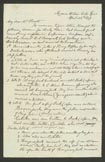 Bulmer to Howitt April 25 1899Registration Number hw0398Author —Physical Description —
Bulmer to Howitt April 25 1899Registration Number hw0398Author —Physical Description — -
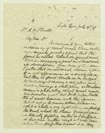 Bulmer to Howitt 29/July/1907Registration Number hw0399Author —Physical Description —
Bulmer to Howitt 29/July/1907Registration Number hw0399Author —Physical Description — -
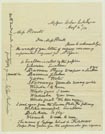 Bulmer to May Howitt 08/1912Registration Number hw0400Author —Physical Description —
Bulmer to May Howitt 08/1912Registration Number hw0400Author —Physical Description — -
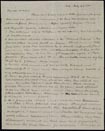 Howitt to Fison 29 July 1880Registration Number tip70-10-34-12Author —Physical Description —
Howitt to Fison 29 July 1880Registration Number tip70-10-34-12Author —Physical Description — -
 Howitt to Fison August 1880Registration Number tip70-10-34-13Author —Physical Description —
Howitt to Fison August 1880Registration Number tip70-10-34-13Author —Physical Description — -
 Howitt to Fison 5 September 1880Registration Number tip70-10-34-18Author —Physical Description —
Howitt to Fison 5 September 1880Registration Number tip70-10-34-18Author —Physical Description — -
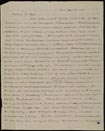 Howitt to Fison 8 October 1880Registration Number tip70-10-34-19Author —Physical Description —
Howitt to Fison 8 October 1880Registration Number tip70-10-34-19Author —Physical Description — -
 Comparative Language ListRegistration Number tip70-10-38-3Author —Physical Description —
Comparative Language ListRegistration Number tip70-10-38-3Author —Physical Description — -
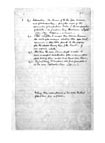 Notes by Howitt about Theories of Mathews and LangRegistration Number XM101Author Howitt, Mr Alfred WilliamPhysical Description Notes, handwritten, ink, undated. Eight sheets, ten pages. Some additional notations in margin. Condition: good
Notes by Howitt about Theories of Mathews and LangRegistration Number XM101Author Howitt, Mr Alfred WilliamPhysical Description Notes, handwritten, ink, undated. Eight sheets, ten pages. Some additional notations in margin. Condition: good -
 Bulmer to Howitt 26 December 1879Registration Number XM80Author —Physical Description Letter, handwritten, ink. One sheet, three pages. Good condition.
Bulmer to Howitt 26 December 1879Registration Number XM80Author —Physical Description Letter, handwritten, ink. One sheet, three pages. Good condition. -
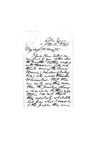 Bulmer to Howitt 30 April 1880Registration Number XM83Author —Physical Description Letter including notes, handwritten in ink. Four sheets, seven pages. Faint annotation top left of first page of letter. Vertical, red-pencil line through text & underlining of some words. Notes may be incomplete. Condition: foxing in one place on front sheet.
Bulmer to Howitt 30 April 1880Registration Number XM83Author —Physical Description Letter including notes, handwritten in ink. Four sheets, seven pages. Faint annotation top left of first page of letter. Vertical, red-pencil line through text & underlining of some words. Notes may be incomplete. Condition: foxing in one place on front sheet. -
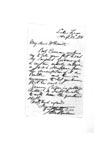 Bulmer to Howitt 30 August 1881Registration Number XM86Author —Physical Description Letter, handwritten, ink. Single sheet, lined note paper. Condition: good.
Bulmer to Howitt 30 August 1881Registration Number XM86Author —Physical Description Letter, handwritten, ink. Single sheet, lined note paper. Condition: good. -
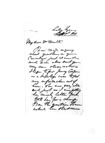 Bulmer to Howitt 1 October 1881Registration Number XM87Author —Physical Description Letter, handwritten in ink. Single folded sheet; two pages. Provenance, and date (overwritten) top right. Condition: tear in paper at top left of first page.
Bulmer to Howitt 1 October 1881Registration Number XM87Author —Physical Description Letter, handwritten in ink. Single folded sheet; two pages. Provenance, and date (overwritten) top right. Condition: tear in paper at top left of first page. -
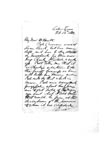 Letter from John Bulmer 13 February 1882Registration Number XM89Author —Physical Description Letter, handwritten in ink. Single folded sheet; three pages. Edge of one page has been repaired. Condition: some foxing.
Letter from John Bulmer 13 February 1882Registration Number XM89Author —Physical Description Letter, handwritten in ink. Single folded sheet; three pages. Edge of one page has been repaired. Condition: some foxing. -
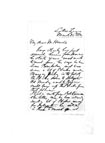 Letter from John Bulmer 25 March 1882Registration Number XM90Author —Physical Description Letter, handwritten in ink. Single folded sheet; two pages. Condition: good.
Letter from John Bulmer 25 March 1882Registration Number XM90Author —Physical Description Letter, handwritten in ink. Single folded sheet; two pages. Condition: good. -
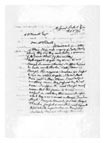 Letter from John Bulmer 8 February 1904Registration Number XM91Author —Physical Description Letter, handwritten in ink. One sheet; two pages. Condition: good but the paper is thin and the handwriting from one side is visible from the other, making reading difficult.
Letter from John Bulmer 8 February 1904Registration Number XM91Author —Physical Description Letter, handwritten in ink. One sheet; two pages. Condition: good but the paper is thin and the handwriting from one side is visible from the other, making reading difficult. -
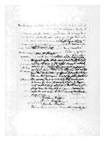 Letter from John Bulmer 11 March 1904Registration Number XM92Author —Physical Description —
Letter from John Bulmer 11 March 1904Registration Number XM92Author —Physical Description — -
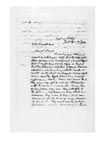 Letter from John Bulmer 29 March 1904Registration Number XM93Author —Physical Description Letter, handwritten in ink. One sheet; two pages. Condition: good, but paper is very thin and the handwriting from one side is visible from the other.
Letter from John Bulmer 29 March 1904Registration Number XM93Author —Physical Description Letter, handwritten in ink. One sheet; two pages. Condition: good, but paper is very thin and the handwriting from one side is visible from the other. -
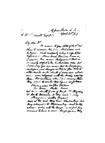 Letter from John Bulmer 22 April 1907Registration Number XM94Author —Physical Description Letter, handwritten in ink. Two sheets; two pages. Condition: good, but paper is yellowing; light rust stains near pin-holes top left.
Letter from John Bulmer 22 April 1907Registration Number XM94Author —Physical Description Letter, handwritten in ink. Two sheets; two pages. Condition: good, but paper is yellowing; light rust stains near pin-holes top left.
